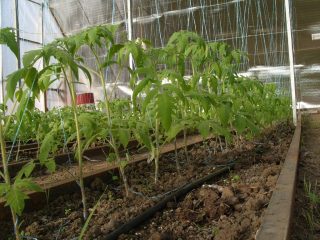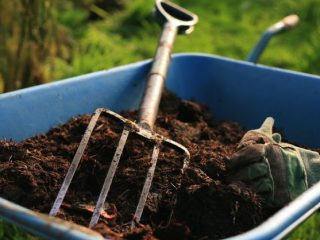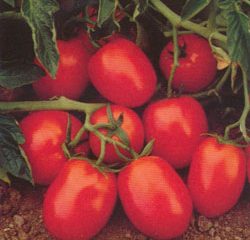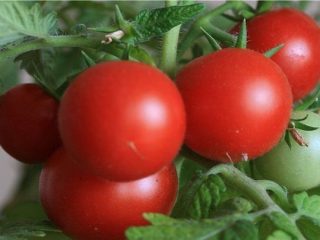Content
- 1 Breeding history
- 2 Description of the tomato variety Burrakersky favorites
- 3 Characteristics of tomato Burraker's favorites
- 4 Advantages and disadvantages
- 5 Landing scheme and rules
- 6 Features of care
- 7 Disease and pest control
- 8 Conclusion
- 9 Reviews from gardeners about tomato variety Burrakersky favorites
The Burrakersky favorites tomato is a large-fruited dessert variety. The fruits are two-colored, with excellent taste.
The variety was named after the Burraker Valley, located in the foothills of the Blue Ridge Mountains.

The pulp of Burrakersky favorites tomatoes is sugary, low-seeded
Breeding history
A new tomato variety, Burracker's Favorite, was obtained as a result of a breeding experiment conducted by American scientists. The bushes are not standard and require regular pinching.
Description of the tomato variety Burrakersky favorites
Tomatoes of the Burraker variety are favorites of unlimited growth vigor (indeterminate), form spreading bushes 1.8-2 m high. The stems are strong and durable, they bend under the weight of the fruit and can break.
The foliage of the tomato bush is good. The leaves are medium-sized and resemble potato leaves in structure. The color is rich green. The top and bottom sides of the leaf plates are matte.

The first flower cluster of tomatoes appears above the seventh leaf, 3-4 fruits are formed in it
Characteristics of tomato Burraker's favorites
Burraquer's favorite tomatoes are large, flat-round in shape, slightly ribbed at the point where the stalk is attached. Fruit weight 600 g. The skin is yellow-red with orange tints. The flesh at the break is pink and dense, with white inclusions and veins. The consistency is juicy, non-watery, with a low seed content.
When it ripens
Burraker favorites are a mid-season tomato variety whose fruits ripen in August. They are harvested 107-112 days after sowing.

Harvested tomatoes are stored for 2-3 months at a temperature of 10-12 °C
Tomato yield Burraker's favorites
The variety has an average yield. From one bush, gardeners manage to collect up to 4.5 kg of fruit, and the yield from one square meter is 10-11 kg. However, tasty, juicy and large tomatoes more than compensate for this shortcoming.
Disease resistance
The tomato variety is resistant to major tomato diseases, as it is endowed with strong immunity. To never encounter rot and fungus, it is enough to follow the schedule of preventive treatments.
Aphids, whiteflies, spider mites and slugs are the main pests of tomatoes. The presence of insects on leaves and other parts of the plant indicates a depressed state of the crop. It is urgent to take measures to combat them.
Where is it grown?
Tomatoes of this variety can be grown in regions where there are sharp temperature changes. In gardening in the middle zone and Siberia, bushes are planted in greenhouses. In the southern regions, Burrakersky favorite tomatoes are grown everywhere without any hassle.

Juicy and sweet tomatoes helped the variety quickly spread and gain popularity in almost all regions of Russia
Methods of application
Tomatoes of the Burrakersky favorites variety have excellent taste. Most often they are used in fresh salads, sauces and juices. The fruits are suitable for canning in slices and are good for slicing.
When eaten fresh, red-yellow tomatoes are good for the cardiovascular system. They protect the body from atherosclerosis, normalize the functioning of the pancreas, and reduce cholesterol levels in the blood. Tomatoes also stimulate kidney function and help relieve swelling.
Advantages and disadvantages
Burraker's favorite tomatoes grow very large. Their appearance and aroma awaken the appetite and cause an irresistible desire to taste it.

Although the tomato skin is thin, the fruits of the Burrakersky favorites variety are not prone to cracking
Pros:
- large fruit size;
- juicy sugary pulp, sweet taste with a fruity aftertaste;
- possibility of growing in a greenhouse and open ground;
- resistance to major tomato diseases and adverse environmental factors;
- universal purpose;
- unpretentiousness.
Minuses:
- Frequent feeding is required;
- bushes need pinching, shaping and staking;
- unsuitable for whole-fruit canning;
- average yield.
Landing scheme and rules
Before planting tomato seedlings in the ground, you need to prepare the area in a special way.If the soil is depleted by previous plantings, then rotted manure, compost, lime or wood ash, as well as some river sand should be added to the digging to make it lighter and looser.

Before planting, seedlings are hardened off, allowing them to adapt to new living conditions.
Algorithm for planting tomatoes in the ground:
- Form holes and spill them with warm water.
- A portion of complex mineral fertilizers is placed at the bottom of each hole.
- Tomato seedlings are placed in them and, holding them, sprinkle the roots with soil. Plants are tied to stakes and the soil is compacted with hands.
After planting, the tomatoes are watered and mulched with freshly cut grass, leaves or straw. In the future, the natural mulching material will rot and additionally feed the plants.
Features of care
Watering should be rare and plentiful. Typically, procedures are carried out twice a week, but taking into account the weather. Severely waterlogged soil promotes the occurrence of root rot. Use warm, settled water, and water the plants in the morning or evening.
Fertilizing is applied depending on the stage of tomato development. In early spring during the growing season, the bushes are fed with nitrogen fertilizers. During the flowering period, they are treated with boric acid, and at the stage of ovary formation, phosphorus-potassium fertilizers are used, which are responsible for the taste of the fruit.

In order for the tomatoes to fill with juice and gain as much sugar as possible, you need to plant the seedlings in the ground on the south side of the site
In addition, an important stage of care is the formation of bushes into two trunks. This procedure guarantees high yields.In the process, the stepsons or, in other words, lateral shoots, which quickly grow and thicken the bush, are removed.
You can nourish tomatoes with infusion of nettle and dandelion. To prepare it, you need to collect about 1 kg of young greenery, chop it, put it in a bucket and fill it with settled water. The foam that will soon appear on the surface will indicate that the infusion is ready.
Disease and pest control
Prolonged rains, fogs, heavy dew and temperature fluctuations can cause late blight, the causative agent of late blight, a common fungal disease of tomatoes.

The disease covers the entire plant, affecting all its organs
Late blight can be recognized by the brown spots that first appear on the leaves. Then brown spots begin to appear under the skin of the fruit, dense to the touch.
To control pests, use a soap solution or infusion based on bitter herbs.

If the number of insects is large, then the drug Actellik will help to quickly destroy them in a proportion of 2 ml per 1 liter of water
Conclusion
The Burraquer favorite tomato bears large and beautiful fruits. The variety is respected by gardeners due to its disease resistance. The tomato is suitable for cultivation in open ground and greenhouses. The fruits are unusually good in summer salads; connoisseurs of sweet tomatoes will appreciate their taste.
Reviews from gardeners about tomato variety Burrakersky favorites











